| Articles:
On
their toes | Rock
around the clock

Cultivating
an identity
Tucked
among the columbines and brick walks of the popular English garden paintings,
one can find the British heart, says art history Assistant Prof. Anne
Helmreich -- that is, if one knows the history.
By
Nancy Bartosek

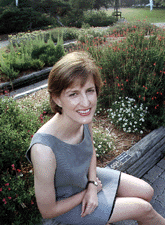 The streets haven't been straightened in that part of Vienna, a still-noisy
section where wares have been peddled since medieval times. Nestled in
the heart of this ancient Austrian city sits a 12th- century Gothic church
that has survived the ravages of age and war.
The streets haven't been straightened in that part of Vienna, a still-noisy
section where wares have been peddled since medieval times. Nestled in
the heart of this ancient Austrian city sits a 12th- century Gothic church
that has survived the ravages of age and war.
It was there
that Anne Helmreich, then a junior studying history abroad before heading
to law school, had her epiphany.
"I was committed
to the idea of exploring the past, but seeing the history of a place through
its art really piqued my interest," she said. "Here was this little cathedral,
like a little jewel box, that was this amazing link to the past. I realized
then that art was such a fascinating way to get into this past."
And for
Helmreich, that has evolved not only into a full-grown passion for turn-of-the-century
English garden paintings, but also a full-scale inquiry into the gardens
themselves -- which the art history expert believes were a national phenomenon
growing out of a need for a national identity. She makes that argument
in the book she's writing and a point she will likely discuss as one of
the professors in TCU's new master's program in art history, underway
this fall.
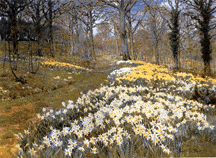 |
| Mother
Nature. William Robinson began espousing his "wild garden" style
in 1870, which he claimed was the true English heritage. His home,
Gravetye Manor, exemplified his belief that visitors to the garden
should feel they are strolling through the countryside. The painting
above, "Spring Woods," by Beatrice Parsons, shows how flowers, always
natural species, would be "stolen between the bushes," or emerge from
grassy areas as though they spontaneously appeared. Though trained
as a garden laborer, Robinson became a gardening journalist and publisher,
amassing a fortune in the process. |
Our England
is a garden that is full of stately views,
Of borders, beds and shrubberies and lawns and avenues,
With statues on the terraces and peacocks strutting by;
But the Glory of the Garden lies in more than meets the eye.
So said
Rudyard Kipling in The Glory of the Garden, his 1910 poem that expressed
the deep connection between the gardens and "being English," Helmreich
said. A belief based on the notion that England was pastoral, rural, founded
on agriculture. But that hadn't been true for 100 years or more.
"Part of
the crisis was about what was happening domestically in England, how the
landscape was changing," she said. "There's a lot of discussion about
how gardens cultivate certain virtues that were disappearing, like tending
a garden makes you more home-oriented, more domestic."
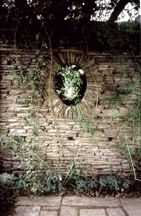 |
| Beauty
from strong backs. This intricately fashioned stone wall in Hestercombe,
a garden created by Gertrude Jekyll and Edwin Lutyens, shows what
grand ideas and cheap labor can produce. The ability of the new professional
class to build elaborate gardens depended on inexpensive labor. After
1914 these gardens fell into disrepair when a whole generation of
workers was lost during World War I. |
Helmreich
was studying English garden paintings for her dissertation when she began
to wonder about their greater cultural significance. What made the prominent
landscapers of the time major news figures? What constituted the heated
discourse about gardening styles, with people arguing vehemently about
the validity of one style over another?
Widespread
controversy about what exemplified the "true" England grew out of the
great gardening debates of the time, she realized. The wild, natural style
of garden writer and publisher William Robinson. The formal, bedded style
promoted by architect Reginald Blomfield. Or a cross-pollination of the
two, which made Gertrude Jekyll somewhat of a national gardening icon.
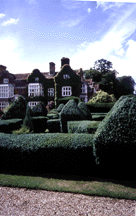 |
|
Hedging
your best.
Near the turn of the century, Robinson's key rival, architect Reginald
Blomfield, revived the formal gardens of the Renaissance, claiming
they were England's authentic gardening style. He believed the garden
should be part of the living area, an extension of the home's architecture.
In Blomfield's formal gardens at Godinton, left, the hedges reflect
the architecture.
|
Helmreich
also stumbled on another cultural surprise -- the popular garden painters
posed problems to critics of the day who were very opinionated about the
painters themselves; the male garden painters were described as "clever,
manly painters,
using broad
brush strokes," which attempted to step over the stereotype that only
women painted flowers -- and, Helmreich adds with a stern look, only indoors.
"It was considered very inappropriate for women to paint on-site." She
laughs.
"So the critics
would say things like, 'Well, she does paint outdoors, and that means
her images are truthful and honest, but don't worry, she hasn't neglected
her children and she keeps to herself, and she doesn't talk to strangers
when she's out painting.' "
The elusive
facts that garden art history tills up are what drives Helmreich's "Our
England is a Garden": National Identity and Gardens in England, 1870-1914,
which will be published by early 2000. It is a work that salvages concrete
messages concealed in lily ponds and vine-covered rock walls.
"I like the
idea of taking these gardens where people think, 'Oh, this would be such
a nice place to go and have a cup of tea,' and going back into the period
where these were made and find out how people talked about them," she
said. "You then realize how absolutely vital these were to the culture,
and how people of the time could read all sorts of messages from these
gardens.
"I like
the idea of recovering those things that we've lost today."
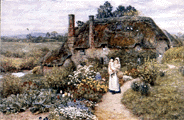 |
Bigotry
in bloom.
Painters of gardens were as popular as the garden designers. This
1909 work, "The Dairy Farm near Crewkerne, Somerset" by Helen Allingham,
shows one of the popular peasant gardens. Despite their talent,
painters, especially women, had to deal with existing bigotries.
"It was something I never thought I'd come across," Helmreich said.
"Critics would say, 'Men know how to draw, women know color. Drawing
takes imagination and power, so it takes male creativity, whereas
color you just look at and see what's in front of you, so it takes
no imagination or creativity and is therefore female.' "
|
| Best
of both worlds. The great garden debates were pruned when Gertrude
Jekyll and Edwin Lutyens began grafting the two together, promoting
wild vegetation within geometric stone borders, exemplified in the
gardens at Hestercombe, right. |

|
Top
|



